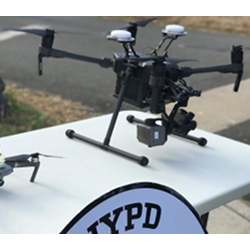
On the heels of the recent launch of the New York Police Department (NYPD) drone program to assist with public safety, opinion is mixed on whether individuals' privacy will be impacted.
The department said the drones will be used when hazardous spills occur, and for documenting crime scenes and collisions. The unmanned aircraft will also be used to monitor pedestrians and traffic during large events.
"All around the country, more and more police agencies are interested in drones, among other spying technology, which is why we think you need to have rules … before police unilaterally spend a lot of money on a tool that might not do much good and might be very intrusive on the public,'' says Adam Schwartz, a senior lawyer with the non-profit digital rights group Electronic Frontier Foundation.
Police departments' use of drones creates "a new frontier for both public safety and abuses of power,'' said New York Civil Liberties Union Associate Legal Director Christopher Dunn in a statement. The NYPD's drone policy "places no meaningful restrictions" on the deployment of drones in the city," according to Dunn, while allowing the department to create a permanent archive of "political activity and intimate private behavior visible only from the sky."
Carlo Ratti, an architect and engineer who serves as director of the Massachusetts Institute of Technology (MIT) Senseable City Lab, says he is mainly concerned about "the asymmetry of information, where just a few companies and public institutions know a lot about us, while we know so little about them."
However, not everyone sees the use of drones in public safety applications as endangering privacy.
"If you are in public, then people see you, but what's the difference if it's a camera mounted at a traffic light or on a drone?" asks Karen Panetta, a professor of electrical and computer engineering at Tufts University and an IEEE fellow. The answer, Panetta says, is that drones make people more aware that they are being watched.
Video footage is more reliable than human recollection, says Panetta, who is also dean of Graduate Education in the School of Engineering at Tufts. "Drones aren't being used to watch your access codes to ATMs or which numbers you dial on your phone,'' she adds. "The drone is looking at public safety and seeks to proactively provide safety and protection, as opposed to evidence collection after something bad occurs."
Yet, Schwartz maintains that if unchecked, drones have the power to document where someone is and what they are doing, especially if captured images are blended with facial recognition technology.
While acknowledging that the NYPD's goal is to advance safety and help police do their jobs more effectively, he says, "this kind of surveillance tool is a great hazard to privacy."
Schwartz believes "there is also the danger of racial disparity." Often, he claims, "these tools are used in minority communities more than white communities."
The NYPD declined to comment, but in a press conference announcing the drone program in December, officials said drones will not be used for warrantless surveillance.
Among other duties, drones will help protect officers assess the situation before going into a crime scene, a department spokesperson said. "It would be negligent for us to not use this technology."
Balancing privacy, public safety
Law enforcement should be able to take every reasonable step to stop a dangerous event from occurring, Schwartz says, but "the price of having safety is that we all submit to a surveillance state, which is using cameras in the sky and on lampposts to capture the faces of everyone making their way through the urban landscape.''
With the increasing strength of facial recognition technology, "government has power it never had before with the flick of switch … to know who is there and who they're with,'' he says. "While most people want to stop terrorism, they haven't signed up for that Orwellian'' level of surveillance.
The question of how to balance the need for enhanced public safety while protecting people's privacy should be determined by city councils after giving people a chance to be heard on the use of drones, Schwartz says.
If a city council does decide to allow drone usage, he says there ought to be significant limits put in place, such as requiring police to obtain a warrant beforehand, "with a reasonable exception for emergencies where someone's life is in danger and there's no time'' to secure a warrant, he says.
The state of Illinois enacted a law several years ago along these lines, Schwartz notes.
"Also, when they do have the warrant for the emergency, they're potentially capturing hundreds and hundreds of faces, and there should be a short deadline for someone to go through the images and figure out which ones are relevant, and which aren't, and quickly delete them,'' he says. "Otherwise, they're building up a database of where presumably innocent people are located."
Ratti notes that in 2012, in partnership with Microsoft, the NYPD adopted the Domain Awareness System, which uses thousands of public-facing surveillance cameras, including many owned by private businesses, to monitor the city.
"However, when asked by Georgetown's Center on Privacy and Technology to disclose information about their technology, they refused,'' Ratti says. "By contrast, San Diego publishes reports on the facial recognition system used by its police and holds public meetings about it. Through such an approach we can be more informed on the systems that permeate our cities and decide—as citizens—how we want to cope with them."
Esther Shein is a freelance technology and business writer based in the Boston area.



Join the Discussion (0)
Become a Member or Sign In to Post a Comment